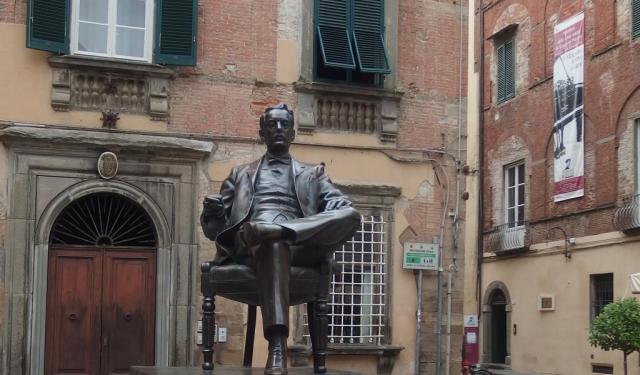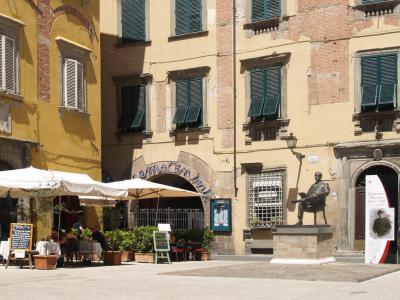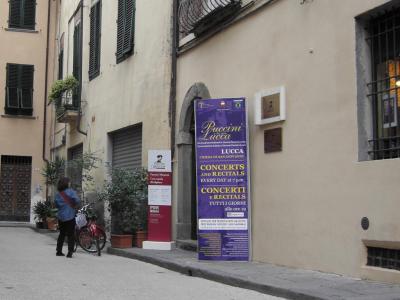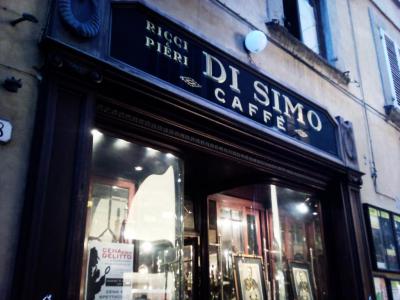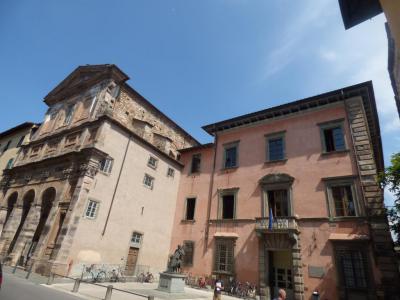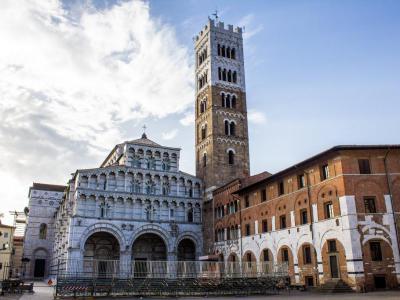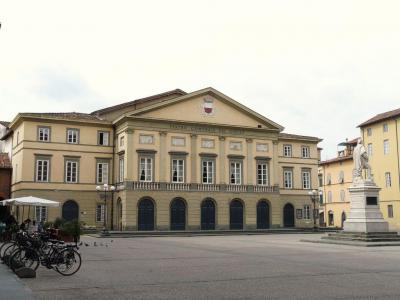Puccini's Lucca (Self Guided), Lucca
One of the greatest musical talents of mankind, Italian composer Giacomo Puccini, was born and spent a substantial part of his life in the Tuscan city of Lucca. Today the legacy of Puccini resonates all over the world and even more so here.
Puccini's ancestors, also musicians, moved to Lucca in 1719. The future maestro was born in a house that had belonged to his family since 1815 – Casa di Puccini (Puccini's Birth Home) on Corte San Lorenzo is now a museum, featuring much the same decoration and furniture as when the Puccinis lived here.
Throughout his life Puccini enjoyed close friendship of Alfredo Caselli, owner of cafe in the historic heart of the city. Cafe Caselli, now known as Caffè Di Simo, was for many years a gathering spot for local intellectuals, artists and musicians.
The Institute of Music that Puccini had attended from 1872 to 1880, now called the Instituto Boccherini, contains many examples of his early work, including a valuable collection of his childhood compositions, as well as the piano and harmonium on which he had practiced.
The Cathedral of San Martino – Puccini’s personal involvement with this temple started when he was at the seminary school. Back in the early 1870s Puccini took part in the Festival of Santa Croce at the cathedral, first as a boy singer, then as a member of the choir, and later as a deputy organist.
The Teatro del Giglio, founded in 1675 – once the cultural point of reference all over Tuscany, is where Puccini rehearsed and attended his opera shows, the most famous of which was Madama Butterfly (1904).
If you wish to follow in the footsteps of the great composer in his hometown, consider taking this self-guided walking tour of Lucca.
Puccini's ancestors, also musicians, moved to Lucca in 1719. The future maestro was born in a house that had belonged to his family since 1815 – Casa di Puccini (Puccini's Birth Home) on Corte San Lorenzo is now a museum, featuring much the same decoration and furniture as when the Puccinis lived here.
Throughout his life Puccini enjoyed close friendship of Alfredo Caselli, owner of cafe in the historic heart of the city. Cafe Caselli, now known as Caffè Di Simo, was for many years a gathering spot for local intellectuals, artists and musicians.
The Institute of Music that Puccini had attended from 1872 to 1880, now called the Instituto Boccherini, contains many examples of his early work, including a valuable collection of his childhood compositions, as well as the piano and harmonium on which he had practiced.
The Cathedral of San Martino – Puccini’s personal involvement with this temple started when he was at the seminary school. Back in the early 1870s Puccini took part in the Festival of Santa Croce at the cathedral, first as a boy singer, then as a member of the choir, and later as a deputy organist.
The Teatro del Giglio, founded in 1675 – once the cultural point of reference all over Tuscany, is where Puccini rehearsed and attended his opera shows, the most famous of which was Madama Butterfly (1904).
If you wish to follow in the footsteps of the great composer in his hometown, consider taking this self-guided walking tour of Lucca.
How it works: Download the app "GPSmyCity: Walks in 1K+ Cities" from Apple App Store or Google Play Store to your mobile phone or tablet. The app turns your mobile device into a personal tour guide and its built-in GPS navigation functions guide you from one tour stop to next. The app works offline, so no data plan is needed when traveling abroad.
Puccini's Lucca Map
Guide Name: Puccini's Lucca
Guide Location: Italy » Lucca (See other walking tours in Lucca)
Guide Type: Self-guided Walking Tour (Sightseeing)
# of Attractions: 6
Tour Duration: 1 Hour(s)
Travel Distance: 1.5 Km or 0.9 Miles
Author: Dee
Sight(s) Featured in This Guide:
Guide Location: Italy » Lucca (See other walking tours in Lucca)
Guide Type: Self-guided Walking Tour (Sightseeing)
# of Attractions: 6
Tour Duration: 1 Hour(s)
Travel Distance: 1.5 Km or 0.9 Miles
Author: Dee
Sight(s) Featured in This Guide:
- Citadel Square and Puccini Monument
- Casa di Puccini (Puccini's Birth Home)
- Caffe Di Simo (former Cafe Caselli)
- Suffrage Auditorium. Boccherini Institute
- Duomo di San Martino (St. Martin's Cathedral)
- Teatro del Giglio (Theater of the Lily)
1) Citadel Square and Puccini Monument
Nestled in the pedestrian heart of Lucca, Citadel Square (Piazza Cittadella) is an essential stop for visitors exploring this historic Tuscan city. The square is renowned for being the birthplace of the celebrated composer Giacomo Puccini, whose legacy remains deeply intertwined with the cultural identity of Lucca. His childhood home, now the Puccini Museum Casa Natale, stands as a tribute to his extraordinary musical achievements and offers a glimpse into his early life.
At the center of the square sits the bronze statue of Puccini, depicted in a relaxed pose on a chair, cigarette in hand. This striking monument is a final homage to the maestro, respected by both Italians and tourists who pause here during their travels to honor his contributions to music. The statue naturally draws the attention of passersby, serving as a focal point of the square’s vibrant atmosphere.
Historically, the square was originally known as Piazza di Poggio, named after the influential Poggio family, one of the most powerful clans in medieval Lucca. However, following their failed attempt to seize control of the city in 1522-an event known as the Conspiracy of the Poggi-the family was exiled, and the square was renamed Piazza del Grano. Later, it took on the name Piazza Cittadella, inspired by a significant Baroque-era building once renowned for its hanging garden, visible from the square.
Citadel Square captures Lucca’s Roman heritage and lively charm. A favorite gathering spot, it’s lined with cafés, pubs, and restaurants. Notable stops include Osteria Tosco, known for its garden setting and local delicacies, and Mercatino di Walter e Lucia, offering gourmet products like olive oils and regional wines. Whether one is drawn by the music, the history, or simply the inviting atmosphere, Citadel Square stands as a living tribute to Puccini and the timeless spirit of Lucca.
At the center of the square sits the bronze statue of Puccini, depicted in a relaxed pose on a chair, cigarette in hand. This striking monument is a final homage to the maestro, respected by both Italians and tourists who pause here during their travels to honor his contributions to music. The statue naturally draws the attention of passersby, serving as a focal point of the square’s vibrant atmosphere.
Historically, the square was originally known as Piazza di Poggio, named after the influential Poggio family, one of the most powerful clans in medieval Lucca. However, following their failed attempt to seize control of the city in 1522-an event known as the Conspiracy of the Poggi-the family was exiled, and the square was renamed Piazza del Grano. Later, it took on the name Piazza Cittadella, inspired by a significant Baroque-era building once renowned for its hanging garden, visible from the square.
Citadel Square captures Lucca’s Roman heritage and lively charm. A favorite gathering spot, it’s lined with cafés, pubs, and restaurants. Notable stops include Osteria Tosco, known for its garden setting and local delicacies, and Mercatino di Walter e Lucia, offering gourmet products like olive oils and regional wines. Whether one is drawn by the music, the history, or simply the inviting atmosphere, Citadel Square stands as a living tribute to Puccini and the timeless spirit of Lucca.
2) Casa di Puccini (Puccini's Birth Home) (must see)
The Puccini Birth Home, located in Corte San Lorenzo, Lucca, is a museum dedicated to the life and works of Giacomo Puccini, one of the most celebrated opera composers in history. This historic house, where Puccini was born on December 22, 1858, and spent his formative years, remains a central piece of the Puccini Museum, preserving the composer’s legacy through an extensive collection of memorabilia, documents, and personal items.
The Puccini family settled in Lucca in the early 18th century, and after the untimely death of Domenico Puccini, Giacomo’s grandfather, in 1815, they relocated to Corte San Lorenzo. His widowed grandmother, Angela Cerù, moved the family there, likely to be closer to her brother Arcangelo Cerù, who provided both moral and financial support to the Puccinis. The house was originally home to multiple generations, including Antonio Puccini, his wife Caterina Tesei, Angela Cerù, and her children, including Michele Puccini, Giacomo’s father.
The museum collection, first established in 1979, has been continuously enriched by private donations and acquisitions. The house was converted into a museum in 1925 by Puccini’s son Antonio, and despite modern enhancements, it retains its original historical appearance. The museum’s restoration efforts have ensured that visitors can experience the home as it was during Puccini’s lifetime, preserving its original furnishings and atmosphere.
Among the notable exhibits inside the museum are Puccini’s Forster and Steinway & Sons pianos, the latter used for composing Turandot. It also features signed scores, manuscripts, rare librettos, and letters with publisher Giulio Ricordi. Highlights include Macchiaioli paintings, hunting trophies, and handwritten drafts of Tosca, La Fanciulla del West, and La Rondine. A standout is a Turandot costume by Umberto Brunelleschi, worn by Maria Jeritza at its 1926 Metropolitan Opera premiere.
The museum includes rooms showcasing Puccini’s personal life, such as the kitchen, veranda, and omnibus room, which holds his funeral mask and portraits. His hunting room displays rifles, boots, and gear. In 1926, his remains were moved to a chapel in the house, where he rests with his family amid musical-themed decor.
Today, the Puccini Birth Home stands as an immersive tribute to the composer’s genius and artistic journey. Located in the heart of Lucca’s historic center, the museum continues to be a cultural landmark, celebrating the enduring legacy of one of opera’s greatest composers.
The Puccini family settled in Lucca in the early 18th century, and after the untimely death of Domenico Puccini, Giacomo’s grandfather, in 1815, they relocated to Corte San Lorenzo. His widowed grandmother, Angela Cerù, moved the family there, likely to be closer to her brother Arcangelo Cerù, who provided both moral and financial support to the Puccinis. The house was originally home to multiple generations, including Antonio Puccini, his wife Caterina Tesei, Angela Cerù, and her children, including Michele Puccini, Giacomo’s father.
The museum collection, first established in 1979, has been continuously enriched by private donations and acquisitions. The house was converted into a museum in 1925 by Puccini’s son Antonio, and despite modern enhancements, it retains its original historical appearance. The museum’s restoration efforts have ensured that visitors can experience the home as it was during Puccini’s lifetime, preserving its original furnishings and atmosphere.
Among the notable exhibits inside the museum are Puccini’s Forster and Steinway & Sons pianos, the latter used for composing Turandot. It also features signed scores, manuscripts, rare librettos, and letters with publisher Giulio Ricordi. Highlights include Macchiaioli paintings, hunting trophies, and handwritten drafts of Tosca, La Fanciulla del West, and La Rondine. A standout is a Turandot costume by Umberto Brunelleschi, worn by Maria Jeritza at its 1926 Metropolitan Opera premiere.
The museum includes rooms showcasing Puccini’s personal life, such as the kitchen, veranda, and omnibus room, which holds his funeral mask and portraits. His hunting room displays rifles, boots, and gear. In 1926, his remains were moved to a chapel in the house, where he rests with his family amid musical-themed decor.
Today, the Puccini Birth Home stands as an immersive tribute to the composer’s genius and artistic journey. Located in the heart of Lucca’s historic center, the museum continues to be a cultural landmark, celebrating the enduring legacy of one of opera’s greatest composers.
3) Caffe Di Simo (former Cafe Caselli)
Caffè Di Simo is a historic café in the heart of Lucca, on Fillungo Street (Via Fillungo), renowned for its deep-rooted connection to the city's artistic and intellectual life. Established in 1846 as Caffè Caselli, it became a cultural hub under Alfredo Caselli, an influential patron of the arts and a close friend of Giacomo Puccini. Caselli inherited the café and its adjoining spice shop from his father, Carlo Caselli, and transformed it into a meeting place for musicians, poets, and painters.
By the early 20th century, the café was a key gathering point for Italian artistic Bohemia, frequented by notable figures such as Alfredo Catalani, Gaetano Luporini, Giovanni Pascoli, Gino Custer De Nobili, Lorenzo Viani, and Gustavo Giovannetti. Many of these friendships were forged through Caselli, whose relationship with Puccini was particularly strong-he often traveled across Europe to attend the composer’s opera premieres.
In 1921, after Caselli’s passing, the Di Simo brothers took over the establishment, giving it the name it still bears today. The café retained its legacy as a literary and artistic salon, commemorated by a plaque installed in 1958 honoring its illustrious guests.
Today, Antico Caffè Di Simo remains largely unchanged from its golden era, preserving its Art Nouveau charm with its dark wood paneling, curved glass windows, and a distinctive gold-lettered sign. Inside, a marble-topped bar, elegant boiseries, and period prints of medieval Lucca set the scene for refined coffee tastings, exquisite pastries, and fine wines. Once a place for cultured conversation, chess games, and cigar-smoking intellectuals, the café continues to be a cherished part of Lucca’s heritage-a living monument to the city’s artistic past.
By the early 20th century, the café was a key gathering point for Italian artistic Bohemia, frequented by notable figures such as Alfredo Catalani, Gaetano Luporini, Giovanni Pascoli, Gino Custer De Nobili, Lorenzo Viani, and Gustavo Giovannetti. Many of these friendships were forged through Caselli, whose relationship with Puccini was particularly strong-he often traveled across Europe to attend the composer’s opera premieres.
In 1921, after Caselli’s passing, the Di Simo brothers took over the establishment, giving it the name it still bears today. The café retained its legacy as a literary and artistic salon, commemorated by a plaque installed in 1958 honoring its illustrious guests.
Today, Antico Caffè Di Simo remains largely unchanged from its golden era, preserving its Art Nouveau charm with its dark wood paneling, curved glass windows, and a distinctive gold-lettered sign. Inside, a marble-topped bar, elegant boiseries, and period prints of medieval Lucca set the scene for refined coffee tastings, exquisite pastries, and fine wines. Once a place for cultured conversation, chess games, and cigar-smoking intellectuals, the café continues to be a cherished part of Lucca’s heritage-a living monument to the city’s artistic past.
4) Suffrage Auditorium. Boccherini Institute
The Suffrage Auditorium (Auditorium del Suffragio) is the former Roman Catholic church (Chiesa del Suffragio) in the historic center of Lucca, which is now used as a theater. The church was erected in 1634 on the site of a cemetery where victims of the plague of 1630–1631 had been buried, and is one of the few temples in the city built from scratch during the 17th century.
Although consecrated in 1646, the church was fully completed only in 1675, when a majestic Baroque altar with four spiral Solomonic columns was installed (presently removed to the Ajaccio Cathedral in Corsica). Of a particular interest is the façade with three orders marked by pilasters, which in the lower register enclose three arches that define a vaulted vestibule offering access into the building. The venue has a seating capacity of over 200 and is used for both musical and theatrical shows.
Next door to the Auditorium is the Instituto Boccherini (Institute of Musical Studies "Luigi Boccherini"), formerly known as the Instituto Pacini, in which young Giacomo Puccini had studied from 1872 to 1880. Among its relics are the valuable collection of Puccini’s childhood compositions, as well as some from his time in Milan (1880-1883), plus the piano and harmonium on which the future maestro practiced. Also preserved here are some compositions by Puccini’s ancestors, donated by his father Michele Puccini, who had taught at the Institute from 1843 and became its director in 1862 – a position he held until his death.
During the years when Puccini was a student, however, the Institute was located at Piazza Santa Maria Forisportam in an ancient monastery complex.
Although consecrated in 1646, the church was fully completed only in 1675, when a majestic Baroque altar with four spiral Solomonic columns was installed (presently removed to the Ajaccio Cathedral in Corsica). Of a particular interest is the façade with three orders marked by pilasters, which in the lower register enclose three arches that define a vaulted vestibule offering access into the building. The venue has a seating capacity of over 200 and is used for both musical and theatrical shows.
Next door to the Auditorium is the Instituto Boccherini (Institute of Musical Studies "Luigi Boccherini"), formerly known as the Instituto Pacini, in which young Giacomo Puccini had studied from 1872 to 1880. Among its relics are the valuable collection of Puccini’s childhood compositions, as well as some from his time in Milan (1880-1883), plus the piano and harmonium on which the future maestro practiced. Also preserved here are some compositions by Puccini’s ancestors, donated by his father Michele Puccini, who had taught at the Institute from 1843 and became its director in 1862 – a position he held until his death.
During the years when Puccini was a student, however, the Institute was located at Piazza Santa Maria Forisportam in an ancient monastery complex.
5) Duomo di San Martino (St. Martin's Cathedral) (must see)
It is said the Cathedral of Saint Martin was founded by San Frediano in the 6th century and rebuilt by Bishop Anselmo da Baggio in 1060. It came into its current form in the 12th and 13th centuries. Anselmo later became Pope Alexander II. In 1372, the apse of the church and the wall of the transept were completed. The style was Gothic.
The facade of the church is in three great arches surmounted by three rows of galleries filled with sculptures. To the right of the facade is the bell tower. It has a four-sided base and five rows of windows divided by pilasters. The crown is made of Ghibeline merlons.
The interior is laid out in a Latin cross with three naves. The two side naves are topped by false galleries. The central nave is contained in a semicircular apse with three large Romanesque windows.
The left aisle has a small chapel holding the sacred relic, the Holy Face of Lucca. The relic is a wooden crucifix with the image of Christ, supposedly carved by Christ's contemporary Nicodemus. It is said to have suddenly appeared in Lucca in 742 AD. The chapel itself was built by Matteo Civitali in 1484. Civitali was a sculptor of Renaissance Lucca.
Off the sacristy is the funeral monument of Ilaria del Carretto, made by the sculptor Jacabo della Quercia. Ilaria was the wife of Paolo Guinigi, Lord of Lucca until 1430. The Lady Ilaria died very young. Her image depicts her lying on the sarcophagus as if asleep, her faithful dog at her feet. Her ghost is said to haunt the Guinigi tower at night.
The Cathedral is also famous for its long association with members of the Puccini family who moved to Lucca from the mountain village of Celle in 1719. Giacomo Puccini’s personal involvement with the Duomo began when he was sent here to attend a seminary school.
The Cathedral, at one time, was a home of two magnificent organs: one from the 15th century and the other from the 17th. Little remains of these instruments today but the gallery and frontal pipes are still visible. From the early 1870s, Puccini took part in the Festival of Santa Croce at the Cathedral, first as a boy singer, then as a member of the choir, and later as a deputy organist.
The facade of the church is in three great arches surmounted by three rows of galleries filled with sculptures. To the right of the facade is the bell tower. It has a four-sided base and five rows of windows divided by pilasters. The crown is made of Ghibeline merlons.
The interior is laid out in a Latin cross with three naves. The two side naves are topped by false galleries. The central nave is contained in a semicircular apse with three large Romanesque windows.
The left aisle has a small chapel holding the sacred relic, the Holy Face of Lucca. The relic is a wooden crucifix with the image of Christ, supposedly carved by Christ's contemporary Nicodemus. It is said to have suddenly appeared in Lucca in 742 AD. The chapel itself was built by Matteo Civitali in 1484. Civitali was a sculptor of Renaissance Lucca.
Off the sacristy is the funeral monument of Ilaria del Carretto, made by the sculptor Jacabo della Quercia. Ilaria was the wife of Paolo Guinigi, Lord of Lucca until 1430. The Lady Ilaria died very young. Her image depicts her lying on the sarcophagus as if asleep, her faithful dog at her feet. Her ghost is said to haunt the Guinigi tower at night.
The Cathedral is also famous for its long association with members of the Puccini family who moved to Lucca from the mountain village of Celle in 1719. Giacomo Puccini’s personal involvement with the Duomo began when he was sent here to attend a seminary school.
The Cathedral, at one time, was a home of two magnificent organs: one from the 15th century and the other from the 17th. Little remains of these instruments today but the gallery and frontal pipes are still visible. From the early 1870s, Puccini took part in the Festival of Santa Croce at the Cathedral, first as a boy singer, then as a member of the choir, and later as a deputy organist.
6) Teatro del Giglio (Theater of the Lily)
Teatro del Giglio (Theater of the Lily) is a historic theater and opera house in Lucca, located in the eponymous Piazza del Giglio (Lily Square). The original theater on this site, known as Teatro Pubblico (Public Theater), was inaugurated in 1675 and later destroyed by fire. A new theater in its place, rebuilt after the Napoleonic war in 1818, features a Neoclassical style with rusticated portico, surmounted by a balustrade upholding pilasters that lead to a tympanum with the coat of arms of the city.
The frieze on the front carries the inscription “Teatro Comunale del Giglio”. The name giglio (“lily”) derives from the fleur-de-lis emblem, which was part of the Bourbon heraldic shield of the reigning duchess, Maria Luisa of the House of Bourbon.
During the 19th century the theater underwent modification, seeing first gas and then electric lights installed – in 1872 and 1911, respectively. Famous all over the world for its extraordinary acoustics, the building became the stage of choice for Giacomo Puccini's operas. Here, from 1891 to 1924, the maestro had personally supervised the staging of Edgar, Manon Lescaut, La Bohème, Tosca, Madama Butterfly, and the Girl of the West.
The theater brought glory to the musician, seeing him progress from “chronicle to myth”. Giacomo Puccini is still very much present at the Giglio today, not only as the name on billboard that pays homage to his greatness every season, but also as the spirit that is felt on the stage, in the boxes and stalls, as well as in the musicality of the typical cadence of the "talk about Lucca".
The Teatro del Giglio is annexed to the Auditorium Theater and the old convent church of San Girolamo’s library holding a fund of approximately 4,000 volumes and recordings of shows since 1985.
The frieze on the front carries the inscription “Teatro Comunale del Giglio”. The name giglio (“lily”) derives from the fleur-de-lis emblem, which was part of the Bourbon heraldic shield of the reigning duchess, Maria Luisa of the House of Bourbon.
During the 19th century the theater underwent modification, seeing first gas and then electric lights installed – in 1872 and 1911, respectively. Famous all over the world for its extraordinary acoustics, the building became the stage of choice for Giacomo Puccini's operas. Here, from 1891 to 1924, the maestro had personally supervised the staging of Edgar, Manon Lescaut, La Bohème, Tosca, Madama Butterfly, and the Girl of the West.
The theater brought glory to the musician, seeing him progress from “chronicle to myth”. Giacomo Puccini is still very much present at the Giglio today, not only as the name on billboard that pays homage to his greatness every season, but also as the spirit that is felt on the stage, in the boxes and stalls, as well as in the musicality of the typical cadence of the "talk about Lucca".
The Teatro del Giglio is annexed to the Auditorium Theater and the old convent church of San Girolamo’s library holding a fund of approximately 4,000 volumes and recordings of shows since 1985.
Walking Tours in Lucca, Italy
Create Your Own Walk in Lucca
Creating your own self-guided walk in Lucca is easy and fun. Choose the city attractions that you want to see and a walk route map will be created just for you. You can even set your hotel as the start point of the walk.
Lucca Introduction Walking Tour
Lucca is called many things: a city of arts, a city of churches, gardens, towers. Most of all it is known for its walls. From Roman times until now the walls have stood. It is the only city in Italy that has kept its walls intact.
The inner walled city is laid out in the ancient Roman grid plan. The Piazza San Michele is the site of the old forum. Bits of the Roman amphitheater can be found in... view more
Tour Duration: 2 Hour(s)
Travel Distance: 2.9 Km or 1.8 Miles
The inner walled city is laid out in the ancient Roman grid plan. The Piazza San Michele is the site of the old forum. Bits of the Roman amphitheater can be found in... view more
Tour Duration: 2 Hour(s)
Travel Distance: 2.9 Km or 1.8 Miles
Lucca's City Wall and Gates
As one of Italy's Città d'arte's (arts towns), Lucca is famous, among other things, for its well-preserved ancient walls encircling the historic center. From about 570 AD until 1847 the city had been the center of the Longobard administration and the capital of old Tuscany, and as such required a defense system to render it an impenetrable fortress.
Back in the Middle Ages, the... view more
Tour Duration: 2 Hour(s)
Travel Distance: 3.7 Km or 2.3 Miles
Back in the Middle Ages, the... view more
Tour Duration: 2 Hour(s)
Travel Distance: 3.7 Km or 2.3 Miles
The Most Popular Cities
/ view all
